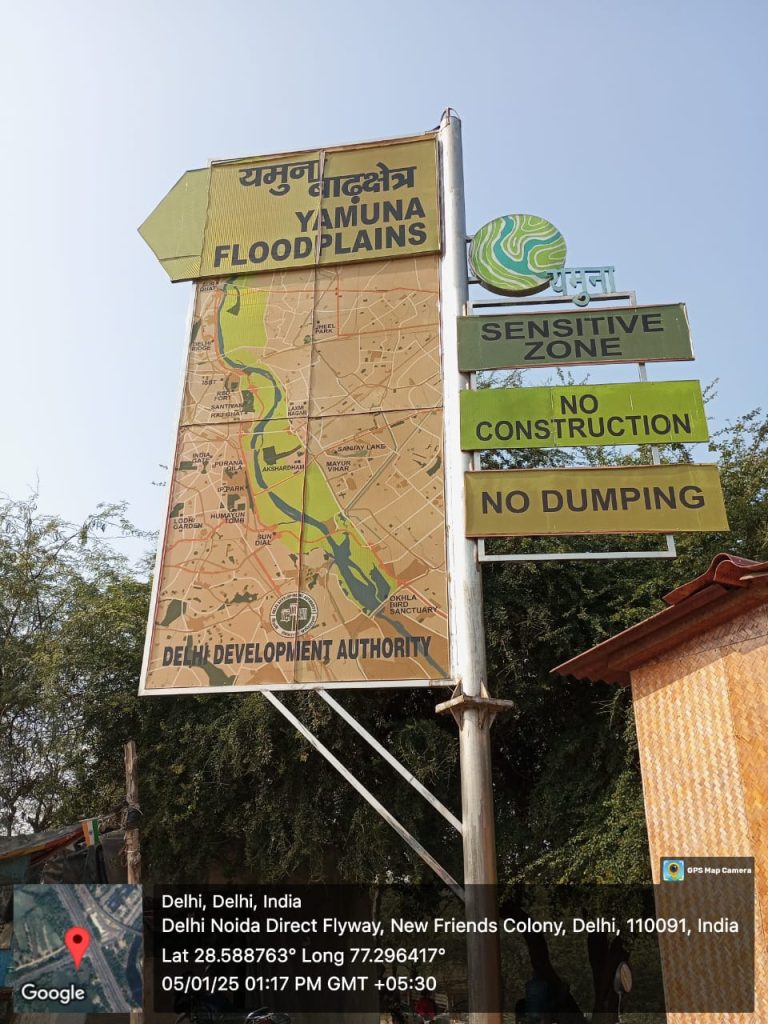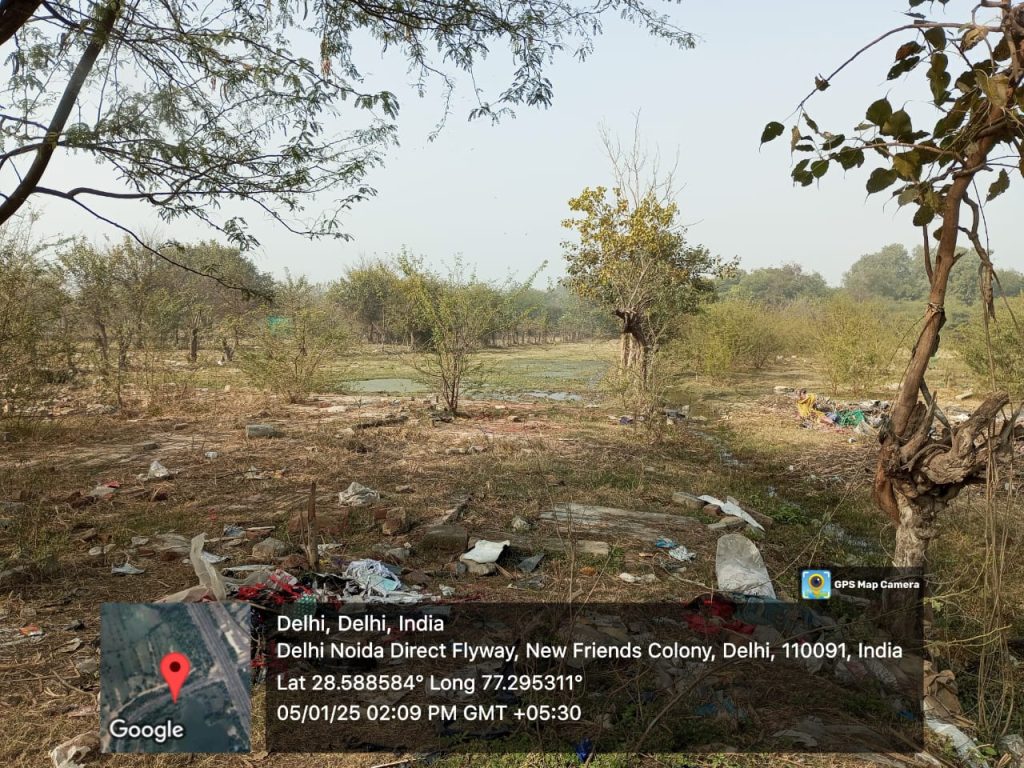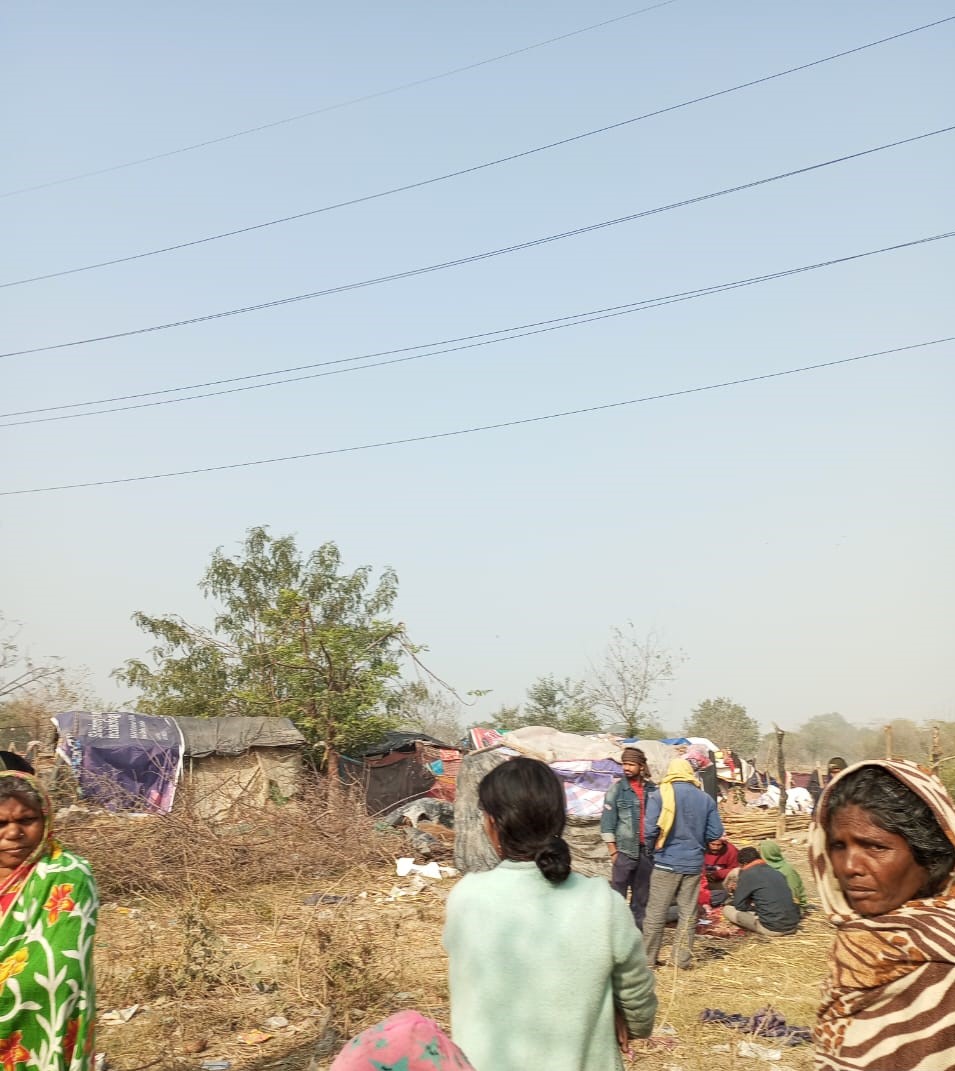Five hundred metres away from this residential area of Mayur Vihar, Pocket 4, lies Chilla Khadar, a settlement on the Yamuna floodplains. Around 250 to 300 households across the Yamuna floodplains face their daily struggles against flood, evictions and systemic neglect. Still, the story of Chilla Khadar is not just like every other story of urban slums in Delhi, as their lives are exacerbated due to the tensions between environmental regulations and the rights of marginalised communities. The Yamuna Rejuvenation Plan, launched by the river rejuvenation committee in 2020, primarily focuses on restoring the quality of River Yamuna by demolishing the encroachments on floodplains, identified as a key source of pollution. While demarcation and clearing of floodplains are crucial from an environmental perspective, the consequences they entail for the livelihood of these marginalised communities are overlooked. The sudden push towards restoration of the ecological significance of Yamuna floodplains had directly affected the shelter and livelihood of families of Chilla Khadar. Moreover, there is no recognition of the right to rehabilitation or opportunities for affordable housing in these settlements.
A glimpse of the community school supported by an NGO left with just a board and a mattress post-eviction.
It was the 5th of July of 2024 when Chilla Khadar witnessed a major demolition of their jhuggis, toilets, school, assets and everything that could be destroyed to pieces. People reported that they were informed of eviction via a notice only a day prior, and the other day, early in the morning, the whole settlement was demolished to bricks and pieces. The residents emptied the space for a month and were left with no alternative, but they came back to their location to rebuild their lives out of the rubble. Amidst this constant cycle of eviction, demolition and rebuilding, the larger question that is overshadowed: Can the Yamuna Rejuvenation Plan ensure sustainable co-existence of ecological protection with social justice, or is it necessary to protect the environment at the cost of the rights of vulnerable communities?
 Pic1: A signboard indicating the sensitive zone of Yamuna floodplains, highlighting the conflict between ecological preservation and human livelihood.
Pic1: A signboard indicating the sensitive zone of Yamuna floodplains, highlighting the conflict between ecological preservation and human livelihood.
A Policy Conundrum of Green Versus Brown Agendas
The tension between the rights of marginalised and environmental protection underscores the larger debate between the “green agenda” and the “brown agenda”. Scholars have advocated for sustainable urbanisation by bridging the gap between the green agenda and the brown agenda. In academic research, Allen et al. (2011 defined the green agenda as typically addressing ecosystem protection, whereas the brown agenda focuses on human well-being and social justice. As per the current concern, Delhi’s environmental regulations primarily focus on river health, ecological protection and city beautification, neglecting the persistent challenges of affordable housing, migrant rights and inclusive urban planning. As per extensive research by Amita Baviskar, it is evident that the neglect is not as recent as policies of environmental protection; the neglect is historic and is traced back to the late 1990s and early 2000s. The conflict between the green agenda and the brown agenda disproportionately affects marginalised communities like Chilla Khadar, turning them into scapegoats for urban environmental challenges.

Pic2: On a chilly winter afternoon, under a smoggy shroud, children aged between six and twelve sit on mattresses at the site where their school once stood, now reduced to rubble by the authorities.
Among the hundreds with persistent fear of eviction, Sushma is a widow and a mother to two daughters. Both of her daughters are married, and now she is the only breadwinner and the only family member. She lives on a monthly income of 3000 to 4000 by working as a house help in the kothi of wealthier people in Mayur Vihar. Due to her old age, she struggles to work for more than one household. She lives on borrowed money from her son-in-law and partially depends on them for her necessities. Her makeshift was destroyed, and she could not build it back as before because of the repurchase value of raw material. While she had a hand pump before eviction, she could not get a new hand pump fixed for herself; she relies on tanker services for her daily water needs. Sushama has lived in the same place for around 25 years; she migrated from her village in Uttar Pradesh with her husband, looking for better working opportunities and better education for their children. For families like Sushma, these regulations as part of the Yamuna Rejuvenation Plan and Master Plan enforcements are not just environmental regulations but existential threats. Each reconstruction of the makeshift costs around 30,000 per household, along with the repurchase of necessary assets like hand pumps, taps, utensils, clothes, books and cots. The eviction not only causes them monetary loss but also loss of school days and income due to no working days for almost a month.
The Global Push for Sustainability Must Embrace Inclusivity
While looking at the local issue from the perspective of a global level challenge, it is evident that the global climate response emphasises ambitious targets for carbon neutrality, energy transitions, riverfront development and conservation of ecological resources. However, these policy objectives fail to consider the social dimensions and vulnerabilities. This disconnect is evident in the localised issue of eviction on Yamuna Floodplains as a part of riverfront development and ecological restoration.
Focusing more on the state-level governance perspective, it is clear that there is a lack of an intersectoral approach in policy making which leads to a compartmentalised policy approach.
Policies like the Delhi Master Plan 2021 and specific directives from the National Green Tribunal (NGT) have prioritised ecological restoration while overlooking the socio-legal complexities of housing rights and historical claims to the land. While crucial for environmental protection, the NGT’s orders on removing encroachments from the Yamuna floodplains often fail to provide adequate rehabilitation or consider the livelihoods of those evicted. Such compartmentalised policymaking hinders sustainable development in urbanising contexts like Delhi, where the “green agenda” often comes at the expense of the “brown agenda” of addressing housing and social equity. It was back in 1996, when the Istanbul Declaration on Human Settlements and Habitat Agenda was adopted as the global action plan for sustainable housing in an urbanising world. Yet, three decades later, cities like Delhi have prioritised riverfront development projects over adequate housing for migrants living in the city for more than 25 years. While civil society cannot stay silent, their voices are muted by the court and green tribunals by justifying these atrocities in the name of environmental protection and restating the vision of a ‘global city.’ These regulations are inconsiderate of the socio-legal complexities of land ownership and the historical ties of communities to these spaces.
The people of Chilla Khadar are not just statistics of eviction reports but also a call towards inclusive policymaking. While protecting the Yamuna floodplain is necessary, it must not be at the cost of those who have lived there for generations. The daily lives of the wealthier groups in the area thrives on the work provided to them by these communities but their contribution to the economy of the capital is neglected beneath the global push towards environmental protection.
Apart from moving beyond the narrow approach of compartmentalised policy-making and green agenda, there is an immediate need to ensure tenure security, provide accessible and affordable resettlement options and address the roots of the housing crisis in overpopulated cities like Delhi.

Pic3: Heavy dumping of plastic and waste in the area
In an interview, the founder of the Centre for Youth, Climate, Law and Environment, Paras Tyagi, stated that the existence of these communities is erased from the very primary level of government policymaking as the demarcation of Yamuna floodplains is done without taking consideration of settlements on the floodplains. Thus, the first step towards the change would be to include the people living on floodplains for decades in the demarcation of Yamuna floodplains. The government’s approach towards planning and policy implementation should include ground realities.
If the policy push towards sustainable development is aimed to be comprehensive, it needs to be inclusive as well. The rights of marginalised communities must be at the heart of environmental policy-making. The objectives can be achieved with inter-department coordination, inclusive objectives of policy making, and consideration of social vulnerabilities. In the end, we need to ask who’s protecting the environment and at what cost. We need to find an answer that includes everyone.
Report prepared by Khushi Sharma, student at Tata Institute for Social Sciences, Mumbai
References
Allen et al (2011). Sustainable Urbanisation: Bridging the Green and Brown Agendas. The Bartlett Development Planning Unit. https://www.ucl.ac.uk/bartlett/development/publications/2011/nov/sustainable-urbanisation-bridging-green-and-brown-agendas
Baviskar A. (2011). Cows, cars and cycle-rickshaws: Bourgeois environmentalism and the battle for Delhi’s streets. Retrieved February 21, 2025, from https://www.researchgate.net/publication/292711263_Cows_cars_and_cycle-rickshaws_Bourgeois_environmentalism_and_the_battle_for_Delhi’s_streets
Compilation of judgements passed with respect to preservation of Yamuna Floodplains, National Green Tribunal, 2024https://greentribunal.gov.in/sites/default/files/news_updates/COMPILATION%20OF%20JUDGMENTS%20PASSED%20WITH%20RESPECT%20TO%20PRESERVATION%20OF%20YAMUNA%20FLOOD%20PLAINS%20in%20EA%20No.%2022%20of%202023%20IN%20OA%20No.%20622%20of%202019%20(Jagdev%20Vs%20Lieutenant%20Governor%20Of%20Delhi%20&%20Ors.).pdf
Istanbul Declaration on Human Settlements and Habitat Agenda, 1996. United Nations Conference on Human Settlements (Habitat II). https://waba.org.my/healthydocuments/development/healthydocuments-doc29.pdf

